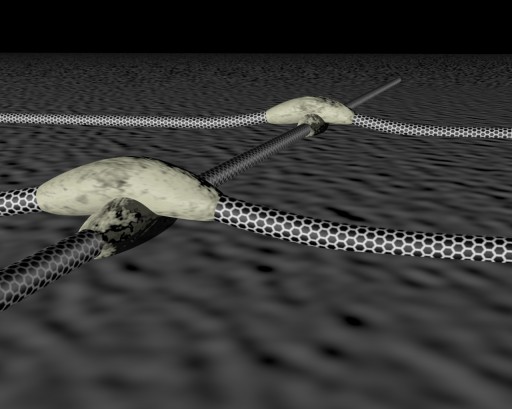Self-soldering nanotubes could replace silicon transistors for flexible electronics
November 27, 2013
Researchers have been exploring using carbon nanotubes as transistors instead of traditional silicon, because they are easier to transport onto alternate substrates, such as thin sheets of plastic, for low-cost flexible electronics or flat-panel displays.
Carbon nanotubes are high-quality conductors, but creating single tubes suitable to serve as transistors is very difficult. Arrays of nanotubes are much easier to make, but the current has to hop through junctions from one nanotube to the next, slowing it down. In standard electrical wires, such junctions would be soldered, but how could the gaps be bridged on such a small scale?
Hot-wiring a nanotube
“It occurred to me that these nanotube junctions will get hot when you pass current through them,” said electrical and computer engineering professor Joseph Lyding, “kind of like faulty wiring in a home can create hot spots. In our case, we use these hot spots to trigger a local chemical reaction that deposits metal that nano-solders the junctions.”
The nano-soldering process is simple and self-regulating (see video). It takes only seconds and improves the device performance by an order of magnitude — almost to the level of devices made from single nanotubes, but much easier to manufacture on a large scale, he said.
[+]

1.
A carbon nanotube array is placed in a chamber pumped full of the
metal-containing gas molecules. When a current passes through the
transistor, the junctions heat because of resistance as electrons flow
from one nanotube to the next. (Credit: Joseph W. Lyding/University of
Illinois)
[+]

2.
The molecules react to the heat, depositing the metal at the hot spots
and effectively “soldering” the junctions. Then the resistance drops, as
well as the temperature, so the reaction stops. (Credit: Joseph W.
Lyding/University of Illinois)
[+]
Nanotube-based computer chips
3. Final result: fully metallized nanotube-nanotube junctions (credit: Joseph W. Lyding/University of Illinois)
“It would be easy to insert the CVD [chemical vapor deposition] process in existing process flows,” Lyding said. “CVD technology is commercially available off-the-shelf. People can fabricate these transistors with the ability to turn them on so that this process can be done. Then when it’s finished they can finish the wiring and connect them into the circuits. Ultimately it would be a low-cost procedure.”
“Other methods have been developed to address the nanotube junction resistance problem, but they are generally top-down and quite slow,” Lyding told KurzweilAI. “Our method is self-aligned and self-limiting and is therefore easily implemented.”
The method is easy to implement and could even be used to create complete computer chips, he said. “We are probably looking at one to three years for commercial applications that incorporate our process.”
The National Science Foundation and the Office of Naval Research supported this work.
1. What are the practical uses of this innovation?
“Transistors fabricated from arrays of carbon nanotubes are potentially low-cost, easy to fabricate and compatible with flexible substrates. Innovations, such as the striping technique developed by John Rogers [Swanlund professor in materials science and engineering] et al. (Nature 454, 495 (2008)) demonstrate these factors while eliminating the unwanted percolation pathways of naturally occurring metallic nanotubes.
A remaining problem with these devices, however, is the high nanotube-nanotube junction resistance, which adds to power dissipation and reduces switching speed by an order of magnitude or more. The work that we have just reported reduces this nanotube-nanotube junction resistance and improves device operation (speed) by about an order of magnitude. We expect the practical uses of this innovation to be in any nanotube-based device that has nanotube-nanotube junctions.
3. How does this innovation compare to others?
researcher Joseph W. Lyding, a professor of electrical and computer engineering at the University of Illinois, explained to KurzweilAI.
Abstract of Nano Letters paper
The performance of carbon nanotube network (CNN) devices is usually limited by the high resistance of individual nanotube junctions (NJs). We present a novel method to reduce this resistance through a nanoscale chemical vapor deposition (CVD) process. By passing current through the devices in the presence of a gaseous CVD precursor, localized nanoscale Joule heating induced at the NJs stimulates the selective and self-limiting deposition of metallic nanosolder. The effectiveness of this nanosoldering process depends on the work function of the deposited metal (here Pd or HfB2), and it can improve the on/off current ratio of a CNN device by nearly an order of magnitude. This nanosoldering technique could also be applied to other device types where nanoscale resistance components limit overall device performance.
(¯`*• Global Source and/or more resources at http://goo.gl/zvSV7 │ www.Future-Observatory.blogspot.com and on LinkeIn Group's "Becoming Aware of the Futures" at http://goo.gl/8qKBbK │ @SciCzar │ Point of Contact: www.linkedin.com/in/AndresAgostini
 Washington
Washington